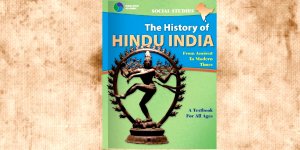| TV Channels / Documentaries |
The History of Hindu India, Part 5/5
History, Documentary
(Tapescript) Namaste. I'm Raj Narayan and this documentary explores modern India, from independence in 1947 to the present day. This concludes our five-part documentary series, "The History of Hindu India."
India's 20th century founders succeeded at welding together the ancient land into a strong, united, modern nation. While almost all of the world's early religions have disappeared, Hinduism survived intact and not only thrives today in the world's largest democracy, but has a global cultural and spiritual influence.
Forging a nation
At the stroke of the midnight hour, when the world sleeps, India will awake to life and freedom. A moment comes, which comes but rarely in history. when we step out from the old to the new when an age ends, and when the soul of a nation, long suppressed, finds utterance. On this day, August 15, 1947, the citizens of India threw off the shackles of their oppressors and joyously celebrated freedom for the first time in over a thousand years. It was an astonishing victory that would usher an equally astounding challenges.
The partition of India at the time of Independence was accomplished at great human cost, as 15 million people abruptly moved from India to East or West Pakistan and vice versa. Over a million Hindus Sikhs and Muslims, many of them in the Punjab region, died in riots and attacks that lasted months.
Gandhi had predicted that with the loss of India, Britain's extensive colonial empire would collapse. Over the next few decades, nearly all the world's colonized nations attained their freedom.
Newly independent India now faced the task of bringing the vast region under a single government. The country was diverse: 800 languages and dialects were spoken among 2,000 ethnic groups. British India had 17 provinces and 565 princely states subordinate to the Raj. All were granted independence, and in theory any of the princely states could have become an independent country. In practice, those within newly formed Pakistan were expected to join that nation, and the rest to become part of India.
The few princely states that resisted, such as Hyderabad, were taken over with swift military action.
"The men under my command were called upon to perform a superhuman task and against very heavy odds. There was no alternative for me left but to surrender."
The ruler of Kashmir delayed making a decision and on October 22nd, 1947, militant Muslim tribals and Pakistani troops invaded the state. The maharaj hastily agreed to join India which then came to his defense. But Kashmir remains divided even today as hostilities never ceased.
In creating the new nation's constitution, India's founders drew upon several sources of modern democracy, including the British and American systems. They also relied strongly on India's historical experience to create a government that would unite India socially and economically and ensure the country's long-term prosperity.
A constitutional committee was formed in 1947 headed by Dr. B.R. Ambedkar of the Mahar jati, a scheduled caste. India's final Constitution established a strong central government under a parliamentary system.
In 1956, the British provinces and the princely states were reorganized along linguistic lines into 14 states India's linguistic diversity is legendary. Each rupee note is printed in 17 languages. Newly independent India faced a host of challenges: political, military, economic, educational, social and religious.
Nehru and India's other great leaders had two key strategies: keep India a democracy in which everyone could participate; and modernize the nation through educational, economic and social development. They were markedly successful. From 1950 to 2010, life expectancy went from just 30 years to 61 years and the literacy rate from 12 percent to 68 percent. The percentage of people living in poverty dropped from 1/2 to 1/4 and the middle class increased from 5% to 17%.
India has massive affirmative action programs called reservations to uplift economically depressed communities by giving preference in university acceptance and quotas in government jobs. Still, women, scheduled castes and religious minorities have a long way to go to achieve a fair share of India's growing prosperity.
Members of Congress, I have the high privilege and the distinct honor of presenting to you His Excellency, Narendra Modi, Prime Minister of the Republic of India.
Today India is the world's largest democracy, has the fourth strongest military and the seventh largest economy. A strong India-US partnership can anchor peace, prosperity and stability from Asia to Africa and from the Indian Ocean to the Pacific. It is a nuclear power playing a strategic role in international affairs while working with the United States and other nations to effect global prosperity and peace. Let us focus not just on matters routine but also on transformational ideas. Ideas which can focus not just on creating wealth but also on creating value for our society. [Applause]
Religion in India
According to the 2011 census, India is 79.8% Hindu, 14.2% Muslim, 2.3% Christian and 1.7% Sikh. Relations between religions in India are generally peaceful, especially at a personal level. However, several religious riots and attacks have occurred at great loss of life.
India is a secular country which in theory means the government does not favor one religion over another. But in practice, this has not always been the case. For example, Indian state governments can and do seize management of Hindu temples and control their income while allowing other religions to manage their places of worship including mosques and churches.
In addition, the laws regarding inheritance, marriage, divorce, adoption and other family issues are different for Hindus, Muslims and Christians. This is unlike the US and other countries where the same laws apply to all citizens regardless of religion. Despite movements to bring communal peace and religious equality to all faiths, this unequal treatment of religions in the Indian Constitution is an ongoing source of discontent and discord.
It may seem strange that it is often the majority Hindu community that is unfairly treated.
Pilgrimage
For at least the last 2000 years, religious pilgrimage has been a popular practice among the Hindus of India. There are hundreds of national pilgrimage destinations, sacred places along rivers, sacred cities, sacred mountains and the country's major temples. Reaching some can be extremely challenging, such as the Holi Amarnath cave at twelve thousand, seven hundred feet in the Himalayas which requires a four day hike. But most are of easy access.
An immensely popular pilgrimage destination is Rameshwaram, not far from Kanyakumari. It was established according to Hindu lore in ancient times by Lord Rama himself who worshiped God Siva here. The central practice of this temple is to take a ritual bath from its 22 wells to atone for past misdeeds. Obviously pilgrims dress with this in mind. Pilgrims here move from well to well in the labyrinthine temple corridors, often at a running pace. At each well they hold firmly in their mind a past deed they regret and want forgiveness for. Wells are said to affect different kinds of karma. Of course, there are skeptics even here who doubt that such release from past karmas is possible, but anyone who has gone through all 22 wells in the two hours it takes has an unexplainable feeling that something extraordinary and purifying has happened to them.
Pilgrimage is so popular in India that family vacations are planned around visits to sacred sites. Through pilgrimage, the population moves fluidly throughout the country thus linking together citizens of various regions.
Hinduism's Impact Today
In our modern world, Hindu ideas have spread far and wide from their origins. In part four we learned about two of these: respect for all religions, taught by Swami Vivekananda, and political change by nonviolent means, exemplified by Mahatma Gandhi.
It may surprise you, but English translations of the Vedas, Upanishads and Bhagavad Gita had an impact on famous 19th century American writers, including Ralph Waldo Emerson, Walt Whitman and Henry David Thoreau. These authors in turn influenced generations of scholars and writers: William James, Herman Melville, TS Eliot and Aldous Huxley, to name a few.
Swami Vivekananda himself came to America multiple times around 1900. Swamis and other Hindu religious teachers visited throughout the 20th century, some establishing organizations propagating Hindu thought usually under the banner of yoga.
In this way, an understanding of key Hindu concepts such as karma, dharma and reincarnation found its way to the West.
"Do you believe in karma?"
"Karma is a word, like love, a way of saying what I am here to do. I do not resent my karma. I'm grateful for it, grateful for my wonderful wife, for my beautiful daughter. They are gifts and so I do what I must do to honor them."
Did you know that one-fourth of all Americans believe in reincarnation? That unexpected number has shown up in polls of religious belief since the 1950s and cuts across religious affiliation.
Hindu practices such as hatha yoga and meditation are now common in Europe and the Americas, so much so that in 2015 the United Nations officially designated June 21st as International Yoga Day. Of course, yoga is central to Hinduism and means more than the hatha yoga system of physical hatha yoga postures now so popular in the West. Hatha yoga poses have fun names, such as downward dog, cobra, plough and lotus that describe the shape the body takes in the position. Within Hinduism, hatha yoga is just one part of a spiritual practice that involves moral and ethical living and deep meditation in an effort to realize the presence of God within.
Ayurveda
Ayurveda, India's traditional and sophisticated system of natural medicine has also gained popularity around the world. The modern idea of holistic medicine considers not only a person's disease but his entire lifestyle, including diet, exercise and emotional life. It comes in part from Ayurveda, which is essentially a science of wellness.
An Ayurvedic doctor, such as Dr. Meena Ramachandran, might start her exam by asking what I eat for breakfast and not by asking what my complaints are. Among Ayurveda's most striking methods is pulse diagnosis, by which a trained doctor can detect irregularities and weaknesses in the organs and gain a sense of the body's overall health. In my case, I'm being advised to cut back on yogurt, take a certain herbal preparation and make some lifestyle changes.
Food and Entertainment
We can't leave India without discussing food and entertainment. Indian cuisine is commonly ranked among the top four in the world along with French, Chinese and Italian. Its main ingredients are rice, wheat flour, dozens of types of beans or, as we say, dals, plus a wide array of fresh vegetables and spices. Like the country, Indian food is complex, varied and richly regional. India's cinema is also regional and therefore multilingual; each filmmaker catering to their niche yet vast audiences.
(Amitabh Bachchan): "Never mind. The cops in eleven countries are waiting for me. But let me tell you something Sonia It's not just difficult to nab Don. It's impossible."
Most popular among the many film industries of India is Bombay cinema commonly known as Bollywood. The name derives from a mix of Hollywood and the city of Bombay now called Mumbai. Bollywood movies with their song and dance sequences are not just wildly popular in India, they have won fans around the globe.
I love Bollywood dancing and the fact that you've fused it with hiphop is really fresh.
Storytelling through film is one more way that India's culture and religion are reaching receptive minds globally.
Conclusion
In 1947, India emerged from two centuries of colonial exploitation with its growth stunted and its people poor and uneducated. As of today it has halved the poverty rate, doubled life expectancy, reached world standards of literacy and become a global high-tech force. India is still a developing country, but on a clear path to resuming her historical position as a leading nation of the world economically as well as spiritually.
Here are six key Hindu ideas influencing our world today. First, respect for all religions, all paths and peoples. Second, a belief in the presence of God in everyone and everything. Third, the principle of ahimsa, non-violence. Fourth, a deep reverence for the Earth and its environment. Fifth, the law of karma. Sixth, that life's purpose is the realization of the divine and spiritual liberation for all human beings.
We conclude this five-part series on the history of Hindu India by pressing our palms together to honor the nation's courageous citizens and the Hindu traditions that have survived for thousands of years despite repeated attacks and oppressions. Namaste and thank you for joining us.
The history of India was created by the editors of Hinduism Today magazine in collaboration with the late Dr. Shiva Bajpai over a period of five years, and reviewed by a panel of academic experts and Hindu community consultants. Hinduism Today was founded in 1979 by Satguru Sivaya Subramaniya Swami (1927 to 2001) to dispel myths and misinformation about Hinduism by informing, educating and inspiring Hindus and non-Hindus worldwide. It is produced quarterly by the monks of Kauai's Hindu monastery in Hawaii. The late Dr. Shiva G. Bajpai served as professor of history and director of Asian Studies at California State University Northridge, Los Angeles from 1970 to 2003. He had a BA and MA from Banaras Hindu University and a PhD from the University of London, UK. He had published numerous articles on Indian history and culture and co-authored the major reference work, A Historical Atlas of South Asia.
YOU MAY ALSO LIKE




